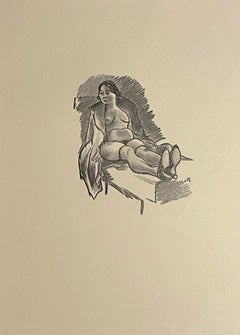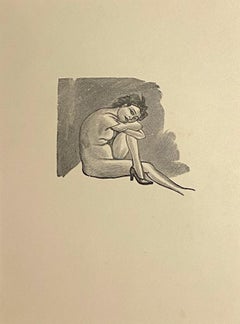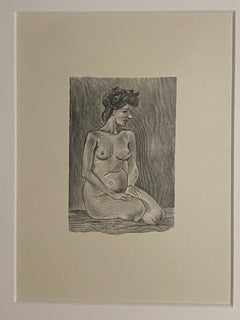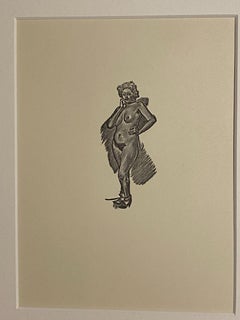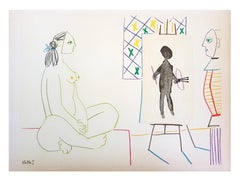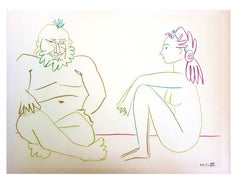1950s Nude Prints
to
35
80
35
18
1
Overall Width
to
Overall Height
to
90
12
2
2
2
1
1
13
10
7
6
5
22
56
1,889
603
27
84
118
132
53
135
206
477
250
104
17
98
35
1
85
48
43
38
24
21
19
12
9
8
6
6
5
4
4
3
3
3
3
3
85
21
19
9
6
14
31
73
61
Period: 1950s
Nude of Woman - Zincography by Mino Maccari - 1950s
By Mino Maccari
Located in Roma, IT
Nude of Woman is an original modern artwork realized the 1950s by the Italian artist Mino Maccari (Siena, 1898 - Rome, 1989).
Original zincography on Ivory paper. Image Dimensions: ...
Category
Modern 1950s Nude Prints
Materials
Paper
Nude of Woman - Zincography by Mino Maccari - 1950s
By Mino Maccari
Located in Roma, IT
Nude of Woman is an original modern artwork realized the 1950s by the Italian artist Mino Maccari (Siena, 1898 - Rome, 1989).
Original zincography on Ivory paper. Image Dimensions: ...
Category
Modern 1950s Nude Prints
Materials
Paper
Nude of Woman - Zincography by Mino Maccari - 1950s
By Mino Maccari
Located in Roma, IT
Nude of Woman is an original modern artwork realized the 1950s by the Italian artist Mino Maccari (Siena, 1898 - Rome, 1989).
Original zincography on Ivory paper. Image Dimensions: ...
Category
Modern 1950s Nude Prints
Materials
Paper
Nude of Woman - Zincography by Mino Maccari - 1950s
By Mino Maccari
Located in Roma, IT
Nude of Woman is an original modern artwork realized the 1950s by the Italian artist Mino Maccari (Siena, 1898 - Rome, 1989).
Original zincography on Ivory paper. Image Dimensions: ...
Category
Modern 1950s Nude Prints
Materials
Paper
The Human Comedy - Lithograph
Located in Collonge Bellerive, Geneve, CH
After Pablo Picasso
The Human Comedy - Lithograph after an original drawing, as published in the journal "Verve"
Printed signature and date Dimensio...
Category
Modern 1950s Nude Prints
Materials
Lithograph
The Human Comedy - Lithograph
Located in Collonge Bellerive, Geneve, CH
after Pablo Picasso - The Human Comedy - Lithograph
Signed and dated in the plate
Dimensions: 32 x 24 cm
This artwork is a lithograph in colors on wove paper after a drawing by Pablo...
Category
Modern 1950s Nude Prints
Materials
Lithograph
The Human Comedy - Lithograph
Located in Collonge Bellerive, Geneve, CH
After Pablo Picasso
The Human Comedy - Lithograph after an original drawing, as published in the journal "Verve"
Printed signature and date
Dimensions: 32...
Category
Modern 1950s Nude Prints
Materials
Lithograph
Marc Chagall - Woman Angel - Original Lithograph
By Marc Chagall
Located in Collonge Bellerive, Geneve, CH
Marc Chagall, Original Lithograph depicting an instant of the Bible.
Technique: Original lithograph in colours
Year: 1956
Sizes: 35,5 x 26 cm / 14" x 10.2" (sheet)
Published by: Édit...
Category
Modern 1950s Nude Prints
Materials
Lithograph
Jacques Villon - Sleeping Nude - Original Etching
Located in Collonge Bellerive, Geneve, CH
Jacques Villon - Sleeping Nude - Original Etching
Circa 1950
Signed in pencil
Edition of 45.
Dimensions : 32.7 x 25 cm
Category
Modern 1950s Nude Prints
Materials
Etching
Pablo Picasso (after) Helene Chez Archimede - Wood Engraving
Located in Collonge Bellerive, Geneve, CH
Pablo Picasso (after)
Helene Chez Archimede
Medium: engraved on wood by Georges Aubert
Dimensions: 44 x 33 cm
Portfolio: Helen Chez Archimede
Year: 1955
Edition: 240 (Here it is on...
Category
Cubist 1950s Nude Prints
Materials
Engraving, Woodcut
Domergue - Naked - Original Signed Lithograph
Located in Collonge Bellerive, Geneve, CH
Original Lithograph by Jean-Gabriel Domergue
Title: Naked
Signed
Dimensions: 40 x 31 cm
1956
Edition of 197
This artwork is part of the famous portfolio "La Parisienne"
Jean-Gabrie...
Category
Impressionist 1950s Nude Prints
Materials
Lithograph
after Henri Matisse - Acrobat
Located in Collonge Bellerive, Geneve, CH
after Henri Matisse - Acrobat
Edition of 200
with the printed signature, as issued
76 x 56
With stamp of the Succession Matisse
References : Artvalue - Succession Matisse
Category
Modern 1950s Nude Prints
Materials
Lithograph
Marc Chagall - Colorful Bible King - Original Lithograph
By Marc Chagall
Located in Collonge Bellerive, Geneve, CH
Marc Chagall, Original Lithograph depicting an instant of the Bible.
Technique: Original lithograph in colours
Year: 1956
Sizes: 35,5 x 26 cm / 14" x 10.2" (sheet)
Published by: Édit...
Category
Modern 1950s Nude Prints
Materials
Lithograph
Pablo Picasso (after) Helene Chez Archimede - Wood Engraving
Located in Collonge Bellerive, Geneve, CH
Pablo Picasso (after)
Helene Chez Archimede
Medium: engraved on wood by Georges Aubert
Dimensions: 44 x 33 cm
Portfolio: Helen Chez Archimede
Year: 1955
Edition: 240 (Here it is on...
Category
Cubist 1950s Nude Prints
Materials
Engraving, Woodcut
Georges Braque Nude 1957 Collotype “Nu Aux Feulles”
Located in Dallas, TX
Collotype after a 1928 drawing by Georges Braque (French, 1882-1963), "Nu Aux Feuilles"
Art Deco, Art Nouveau nude of a woman.
From the “Braque Espace” portfolio by Daniel Jacomet 19...
Category
Art Deco 1950s Nude Prints
Materials
Paper
